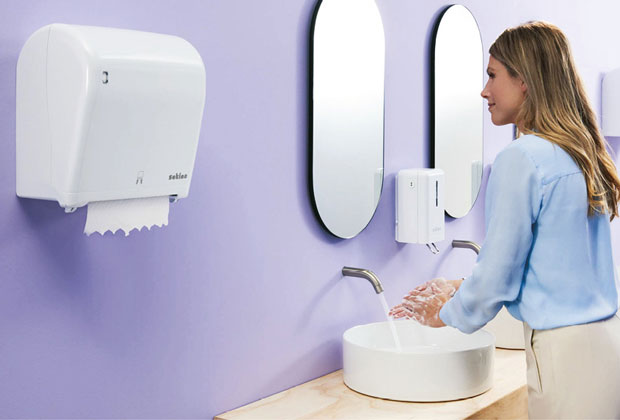 Alasdair Sharp, Satino by WEPA UKI Sales Manager, explains why implementing a sustainable strategy can help reduce the washroom’s environmental impact
Alasdair Sharp, Satino by WEPA UKI Sales Manager, explains why implementing a sustainable strategy can help reduce the washroom’s environmental impact
With COP 28’s incentive to limit the global temperature rise to 1.5 degrees Celsius, environmental strategies are more important than ever, with businesses being pressed to adopt more proactive, planet-first measures to address their global impact on the environment. Research also shows that more end users want to support sustainable businesses; for instance the Capgemini Research Institute revealed that 77 per cent of consumers are now more willing to spend with a company that has a corporate social responsibility pledge.
Yet for many organisations aiming to decrease their environmental impact, one area which is often overlooked as part of a wider sustainability strategy is the washroom. By making more sustainable choices in this space, you can not only reduce your environmental footprint but also gain a competitive edge in the market by appealing to eco-conscious consumers. From a commercial and ESG (Environmental, Social and Governance) point of view, implementing a greener approach is therefore well worth the investment.
Hygiene strategies within the washroom can be a small but significant change to a business’ overall impact on the environment. This can include choosing ethical and sustainable products, investing in touch-free tech, and ensuring that chosen suppliers align with environmentally-friendly regulations.
SWITCHING TO SUSTAINABLE SUPPLIERS
Ethical procurement has emerged as a powerful influence for conscious consumerism and corporate responsibility, operating as a strategic choice which dictates an organisation’s impact on the environment. Opting for sustainable suppliers is fundamental in creating an ethical supply chain that benefits both your reputation and the planet. Choosing the right products for your washroom can make a big difference, yet switching suppliers is an easy step towards strengthening your business’ environmental strategy.
PLANET-FRIENDLY HYGIENE PAPERS
With a wide choice of responsible options now available on the market, when it comes to achieving sustainability goals, washroom products can no longer be treated as an afterthought.
The hygiene paper used in the washroom presents a prime opportunity for reducing environmental impact. The paper industry is among the top five most energy-intensive industries and accounts for approximately two per cent of direct industrial CO2 emissions. The pulp and paper industry uses between 33-40 per cent of all industrial wood traded globally, which represents a huge contributing factor to deforestation and consequently the loss of biodiversity, extinction of species and the further disruption of our ecosystem.
It is therefore imperative that businesses consider a sustainable option for their hygiene papers. Products made from old corrugated cardboard (OCC) are one of the latest innovations helping to reduce the impact of deforestation. This is because the shredding and pulping phases for OCC are powered by renewable energy sources which use less energy and water compared to traditional methods concerning raw materials. By switching to hand towels or hygiene papers made from OCC, businesses can contribute to the reduction of mass pulp and paper production and its environmental impact.
Choosing a sustainable route also involves considering the ingredients within products such as hand soaps. Twelve million tonnes of plastic find its way into the ocean every single year, equating to eight million pieces of plastic entering the ocean every day, resulting in a significant impact on the marine ecosystem and our food chains. Switching to plastic-free items is a small change but can help shrink overall environmental impact. Choosing liquid and foam soaps that are formulated without synthetic polymers, which are a liquid form of microplastics, will prevent harmful physical and toxicological risks to organisms in our oceans, reducing pollution in our oceans.
OPTIMISING TOUCH-FREE TECHNOLOGY
Making sustainable choices within the washroom extends beyond the use of recycled hygiene paper and non-synthetic polymer soaps. Touch-free technology is an easy sustainability strategy that facilities managers can introduce into their washrooms.
Touch-free taps, for example, automatically turn off to reduce water waste, and motion sensor lights help with energy efficiency by only turning on when needed. Sensor-operated dispensers require fewer refills than manual alternatives, meaning more energy efficiency and less wastage of products, while the resulting reduced workload for cleaners and the facilities team provides a further overall commercial benefit.
It is estimated that approximately 80 per cent of infections are spread by touch and, in 2023, 32 million working days were lost in Great Britain due to work-related illness. Implementing touch-free technology can therefore also help reduce the spread of infection whilst simultaneously limiting environmental impact. Establishing an accessible and comprehensive hygiene strategy will not only support the challenges of workplace cleanliness, but also enable businesses to plan and budget for purchases.
 Implementing a sustainable washroom strategy is an achievable goal which can have a substantial impact on a business’ environmental footprint. By switching to sustainable suppliers and products and installing touch-free technology, enterprises can align with eco-regulations and improve their ESG performance. Beyond the environmental advantages, enhancing workplace hygiene also promotes staff wellbeing while improving ESG. This then leads to a commercial advantage by positioning your business as an environmentally conscious enterprise – something that’s well worth the investment.
Implementing a sustainable washroom strategy is an achievable goal which can have a substantial impact on a business’ environmental footprint. By switching to sustainable suppliers and products and installing touch-free technology, enterprises can align with eco-regulations and improve their ESG performance. Beyond the environmental advantages, enhancing workplace hygiene also promotes staff wellbeing while improving ESG. This then leads to a commercial advantage by positioning your business as an environmentally conscious enterprise – something that’s well worth the investment.





